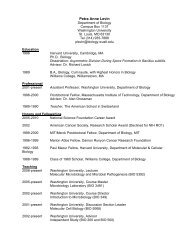Guide for doing FRAP with Leica TCS SP2 - Biocenter
Guide for doing FRAP with Leica TCS SP2 - Biocenter
Guide for doing FRAP with Leica TCS SP2 - Biocenter
You also want an ePaper? Increase the reach of your titles
YUMPU automatically turns print PDFs into web optimized ePapers that Google loves.
<strong>FRAP</strong>Note: For fitting eqn 4 to the data it must be normalizedand plotted <strong>with</strong> the time point of the first postbleachimage t 0 = 0 s.ModelingMore accurate estimates of D can be achieved by fittinga mathematical model numerically to the imageseries recorded (In this case not only the integratedROI intensities, but the whole image data are used).One such simulation <strong>for</strong> recovery of a strip bleach ROIhas been published by Siggia et al. (2000). Other simulationpackages dealing <strong>with</strong> diffusion or reactive flowscan be suitable, too, but usually require a considerableamount of work to implement a simulation tailored <strong>for</strong>live cell image series. The authors plan to publish soona web-based tool <strong>for</strong> quantitative <strong>FRAP</strong> analysis ontheir homepage (http://www.dkfz.de/ibios/index.jsp).T..absolute temperatureη..Viscosity of solventr Η ..hydrodynamic radius of solute moleculeswhere r Η can be estimated using the empirical equation(Braeckmans et al. 2003):r Η = 0.015 ∗ Μ w0.53 (8)WithΜ w ..molecular weightNote: This is only the case <strong>for</strong> dextransFrom the D obtained the characteristic relaxation timeτ and the recovery half-time t 1/2 were estimated usingD = w 2 /(4τ). Since two approximations have been madeto obtain these parameters, they will be rather inaccurateand are there<strong>for</strong>e spelled in parentheses.Evaluation of demoexperimentsIn this section our showcase examples, namely FD464 and the H1-GFP cell, will be examplarily evaluated.FD 464Figure 5, upper row, contains integrated fluorescenceintensities <strong>for</strong> the bleach ROI (green) and a ROI comprisingthe whole cell (purple). The “whole cell” ROI(purple) covers the complete field of view. In the caseof FD464 it was not possible to define a ROI <strong>for</strong> backgroundintensity, like in H1-GFP (cyan). For backgroundsubtraction an image was taken using therespective photomultiplier <strong>with</strong> lasers turned to 0%.Table 1 summarizes the results.In the left column the experimental results are given.FD464 theor are the expected values <strong>for</strong> M f and D. Sinceall FD464 molecules are free to diffuse we expect mobilefraction to be 100%. The experiment shows thatnicely. The 3 % deviation could be attributed to noiseor, more generally, errors during estimation of F infcell .The theoretical D value was estimated using theStokes-Einstein equation,D = k ∗ Τ/(6πηr Η ) (7)With k..Boltzmann constantH1-GFPThe green curves in the right column graphs of Figure 5show clearly a much slower recovery rate <strong>for</strong> the H1-GFP construct under in vivo conditions. Such a slowrecovery can be indicative of molecular interactions(between histone H1 and chromatin in this case).ROI2 in H1-GFP stays relatively constant, but the intensityincreases by a few percent towards the end ofthe experiment. In general, such an increase couldindicate specimen movement or flux from image planesabove or below the one observed. Such effects cansometimes complicate the quantitative analysis of a<strong>FRAP</strong> experiment. The corrected curves in the middlerow of Figure 5 demonstrate the correction <strong>for</strong> fluorescenceloss during acquisition (needed <strong>for</strong> calculationof M f ) using the whole cell ROI. The bottom row containsthe normalized bleach ROI data together <strong>with</strong> asingle exponential fit, similar to the fit used by LCS tocalculate the time constant of the recovery. Table 1summarizes the results. Note, that the time constantdepends (among other parameters) on the bleach ROIgeometry, as shown by comparing an arbitraryly shapedROI in Figure 5 and a circular ROI in Figure 6. The timeconstants determined here lie <strong>with</strong>in about 10% deviationof previously published results <strong>for</strong> H1-GFP (Misteliet al. 2000). If more than a rough estimate is desired,an appropriate model should be chosen (comp. Braeckmanset al. 2003). The same holds true <strong>for</strong> the timeconstants (D eff ) estimated <strong>for</strong> the FITC-dextran solution.Confocal Application Letter 9











